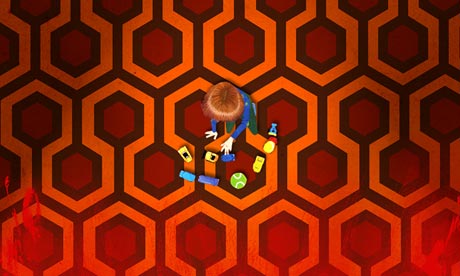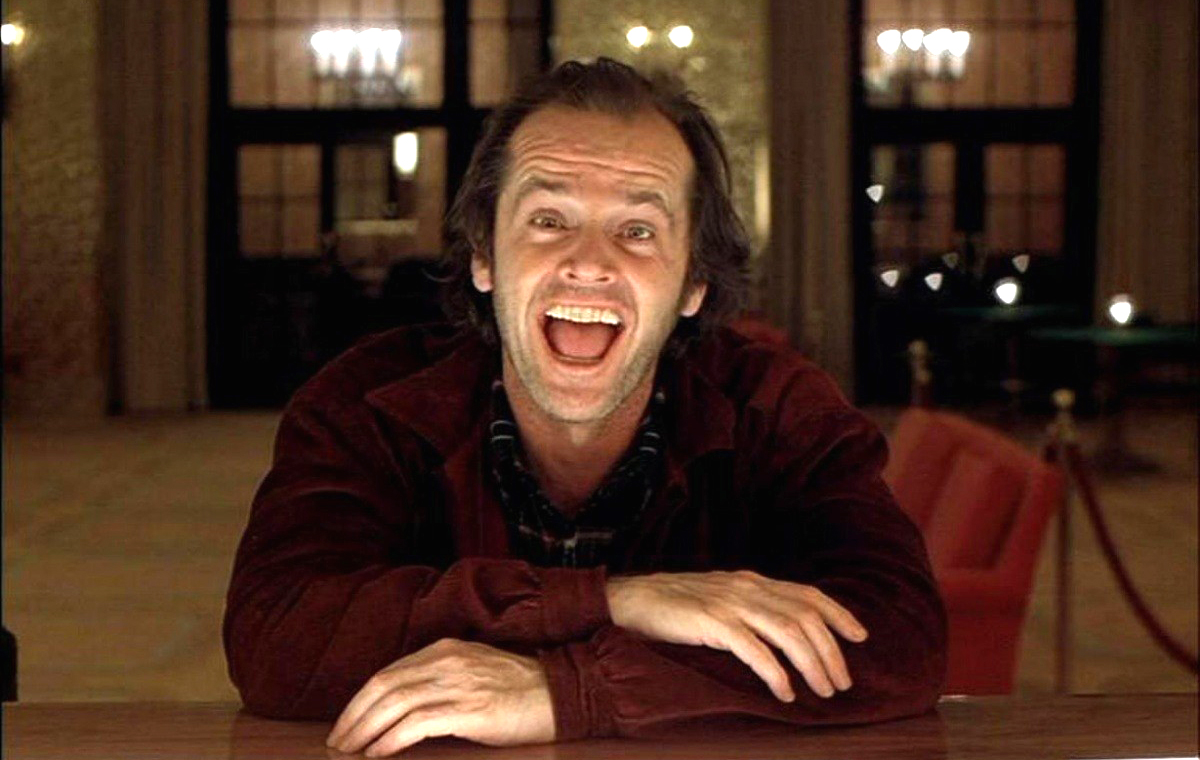When Stanley Kubrick’s horror film “The Shining” came out in
1980, one of the major criticisms it received—besides the fact that it deviated
so much from the original Stephen King novel—is that it felt like an
underwhelming exercise from the aging filmmaker. Kubrick had made such
challenging and bold pictures as “2001: A Space Odyssey” and “ A Clockwork
Orange”; what was he doing making a horror movie about a family that goes to
look after a hotel for the winter that turns out to be haunted? In other words,
people wanted more from Kubrick.
As with most Kubrick films, “The Shining” eventually went on
to be re-viewed and regarded as a classic. It’s one of my favorite movies of
all time and I think the reason why it’s so great is because it can be watched
and appreciated on two levels. It can be enjoyed on a skin-deep entertainment level;
the story and characters are compelling and contain Kubrick’s usual directorial
flair (tracking shots, the uses of classical music, etc.). In addition, the
movie is incredibly effective as a horror film because—like all great horror
films—Kubrick doesn’t rely on empty “gotcha!” scares or a large amount of blood
and gore. Instead he simply presents a terrifying image, (two ghostly girls, or
a tidal wave of blood flowing out of an elevator) maybe abruptly or maybe not
and then through craft (cinematography, or a music queue played at just the
right moment) he lets the scary image speak for itself.
At the same time however, there are puzzles and ambiguities
all over “The Shining.” Kubrick asks a number of questions but doesn’t
necessarily answer all of them, instead letting the audience members draw their
own conclusions. This is different from the novel. King’s 1977 book is a good,
pulp horror read but once it’s done, it’s done. There’s really no reason to go
back to it, whereas there is plenty to go back to and look at in Kubrick’s film.
For example, the novel is about ghosts,
but in the movie the supernatural happenings at The Overlook could be actual ghosts or a result of
cabin fever, or a combination of both.
But then there are
the ambiguities that are more…out there. Ones that have to do with various
social and historical concerns. In Rodney Ascher’s documentary “Room 237”, all
of the supposed hidden meanings and subtexts of “The Shining” are explored. The
film—which played at the 2012 Cannes film festival— is admittedly trivial but
is an awful lot of fun to watch and highlights the pleasures in analyzing (and
perhaps overanalyzing) a movie. He brings together film historians,
journalists, film archivists, and filmmakers who are all convinced they’ve
unlocked the secret meaning buried within Kubrick’s film.
We never see their faces; only hear their voices as they
walk us through scenes from the movie, pointing out the various clues. It’s
sort of like a video essay. Since I don’t want to spoil the entire experience
for you I’ll just briefly go over three of the major theories that are
discussed. The first one comes from ABC reporter Bill Blakemore, who thinks
that the entire movie is metaphor for the genocide of the Native Americans. He
points out such clues as the Calumet brand of baking powder in the background
of a couple scenes, the Native American decorations all over the hotel lobby
and the fact that the hotel was buried atop an Indian burial ground. The second
theory comes from film historian Geoffrey Cocks, who thinks the movie reflects
Stanley Kubrick’s concerns with the Holocaust. At one time Kubrick was planning
to make a Holocaust movie but when Steven Spielberg started making “Schindler’s
List” he thought the two projects were too similar and stopped. Cocks thinks
since Kubrick could never directly address the Holocaust, he did it indirectly
and he sees Holocaust references all throughout Kubrick’s body of work. The
third theory is the probably the most wacko of the theories and so all I’ll say
about it is that it links “The Shining” to the famous Apollo 11 moon landing
footage (and the supposed artificiality of it). The organization of the movie
can be a little clunky, Ascher jumps from one theory to another and back again,
although I suppose he partly does that to show where the different theories
overlap with each other.
Now, I realize these theories sound ridiculous and a few of
the smaller theories (one involving a Dopey sticker on Danny’s bedroom door)
feel too far fetched but the theorists support their wild claims with evidence
from the movie, and so you can’t just write them off right away. You also have
to remember that Stanley Kubrick was incredibly intelligent, a great chess
player and was known to be a perfectionist when it came to shots and
compositions in scenes. Blakemore even mentions seeing a picture of Kubrick
stacking cans and boxes of food in the pantry part of the hotel set where the
Calumet cans are. Kubrick liked to make challenging films and so it’s very
possible that he had one, or maybe more, of these themes in mind while making
it and put in these subtle clues for the viewer.
 Whether any of these theories are “right” or “wrong,” “Room
237” reminds us of one of the great things about cinema and art in general. We
all have a different perspective and interpretation of a movie or work of art,
influenced by our backgrounds, interests and our overall outlook on the world.
Even though these theorists are watching the same movie, they all took
different meanings out of it. Art is subjective and so there’s no one right
answer. Kubrick may not have intended any of those underlying themes but it’s
those underlying themes that have kept the movie alive. It’s thirty years later
and people are still talking about “The Shining,” still analyzing it and still
enjoying it. That’s why it deserves to be among all of the other great films in
history.
Whether any of these theories are “right” or “wrong,” “Room
237” reminds us of one of the great things about cinema and art in general. We
all have a different perspective and interpretation of a movie or work of art,
influenced by our backgrounds, interests and our overall outlook on the world.
Even though these theorists are watching the same movie, they all took
different meanings out of it. Art is subjective and so there’s no one right
answer. Kubrick may not have intended any of those underlying themes but it’s
those underlying themes that have kept the movie alive. It’s thirty years later
and people are still talking about “The Shining,” still analyzing it and still
enjoying it. That’s why it deserves to be among all of the other great films in
history.
3.5/4
Note: This rating is really only mean't for people who are fans of "The Shining" or who are really interesting in film analysis and interpretation. I'm not sure how wide of an audience it will attract.



No comments:
Post a Comment